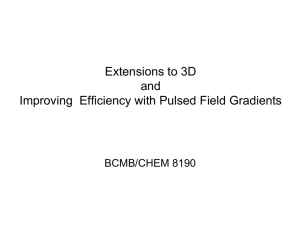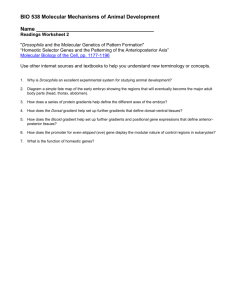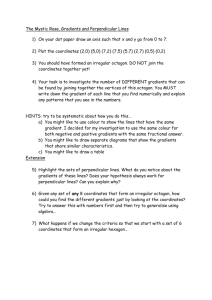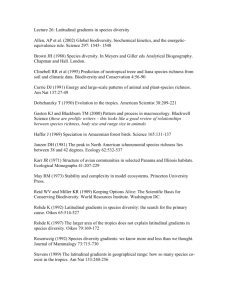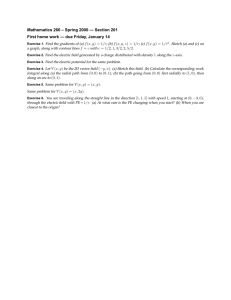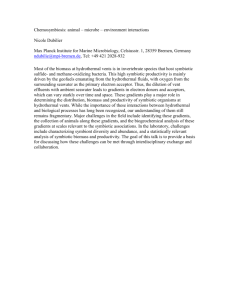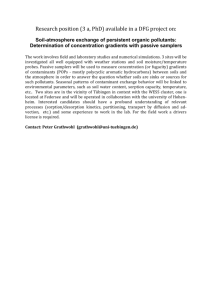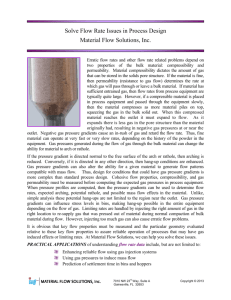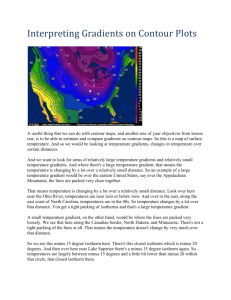Extensions to 3D and Improving Efficiency with Pulsed Field Gradients BCMB/CHEM 8190
advertisement
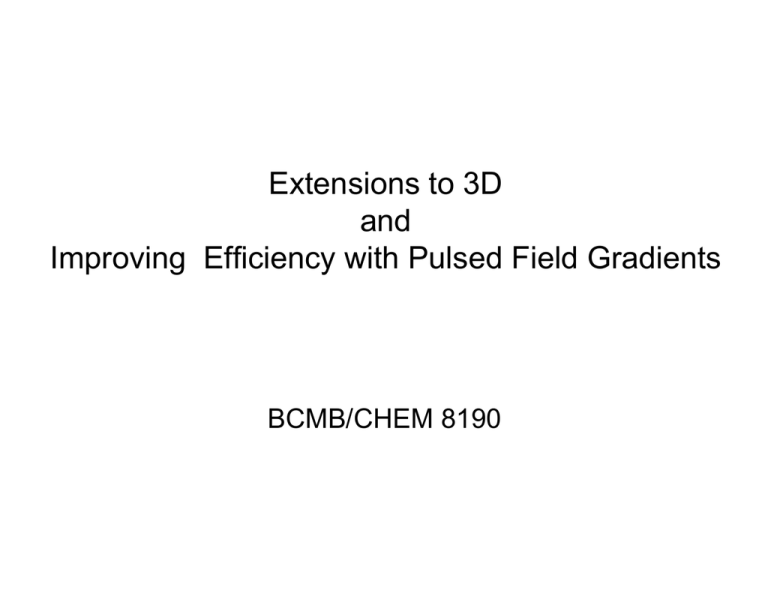
Extensions to 3D
and
Improving Efficiency with Pulsed Field Gradients
BCMB/CHEM 8190
2D NMR spectra can
get very crowded
2D NOESY of
Staph- Nuclease
156 AA
Solution: go to 3D
3D experiments used for sequential resonance assignments:
Can detect Cα in 3D by INEPT enhancement of 13C, transfer
from 13C to 15N then from 15N to 1H (HNCA). Many others:
3D
=
=
O H Hα O H
- - - C N Cα C N - - H - Cβ - H
H
f1 (13C)
(HB)CBCA(CO)NH
f3 (1H)
f2 (15N)
=
=
O H Hα O H
- - - C N Cα C N - - H - Cβ - H
2D
(HA)CANH
1D
H
HNCACB
Strategy for Constructing 3D Experiments:
Combine various 2D Experiments
combine more?
Cavanagh et al 1996
4D
3D TOCSY-HSQC
Cavanagh et al 1996
TOCSY-HSQC for 15N-Labeled Ubiquitin
Cavanagh et al 1996
Pulsed Field Gradients:
More Efficiency in Multidimensional Spectra
• Coherence selection using pulsed field
gradients. J. R. Tolman & J. H. Prestegard,
Concepts in Magnetic Resonance, 7, 247-262
(1995).
• Water suppression (WATERGATE), M. Piotto, V.
Saudek & V. Sklenar, J. Biomol. NMR, 2, 661665 (1992).
• Diffusion measurements. Altieri, Hinton & Byrd,
J. Am. Chem. Soc., 117, 7566-7567 (1995).
Pulsed Field Gradients – How they Work
i
B’
B0
i
B0(z)
z
G(z)
time
Magnetization vectors precess at different
rates depending on G(z) and γ for each volume
element. They dephase - net Mx, My = 0.
Reversal of gradient refocuses magnetization.
Effects of Gradients can be Refocussed
Application: Water Suppression
90x
90-y
G1
Resonance not
affected by 90
refocuses
Resonance
affected by 90
dephases (H2O)
180y
90-y
z
z
x
y
ωa ωb
z
ωa
x
ωb
z
ωa
ωb
y
x
z
z
ωb
yx
G1
ωa
y x
x
z
ωa
ωa
ωb y x
ωb
ωa
y
ωb
y
1D 1H Water-Suppressed Spectrum
Pf-Rubredoxin in 1H2O
12
10
8
6
4
2
0
-2
ppm
Translational Diffusion Constants
for Macromolecules
• Determine aggregate size
• Determine protein-protein interactions
• Screen for bound ligands
r
• <(X1-X0)2> = nDt where D = kT/(6πηr)
• Key: if molecule moves, field is different,
magnetization doesn’t refocus
Stejskal and Tanner Pulse Sequence
for Diffusion Measurement
90x
180y
δ
δ
gz
gz
Δ
•ln[S/S0] = -γ2g2Dδ2(Δ - δ/3)
Diffusion Measurement Continued
• Measurements are limited by natural T2
• Improved sequence uses z storage
(Altieri, Hinton and Byrd, 1995)
Large molecule
ln(S/S0)
Small molecule
g2
Coherence Selection Using Pulse Field Gradients
• H(r) = -Σkγk [B0 + Bz(r)]Ikz
(in radians s-1 and neglecting chemical shifts)
• Effects on product operators for a z gradient:
• Ikz
-γk Bz(z) Ikz τ
Ikz
B’
• Ikx = (Ik+ + Ik- )/2
B0
z
• Ik+
-γk Bz(z) Ikz τ
exp[i γk Bz(z) τ ] Ik+
• Ik-
-γk Bz(z) Ikz τ
exp[-i γk Bz(z) τ ] Ik-
• For linear gradients Bz(z) = Gz z
• Observables are integrals over z – zero for Ik+ , Ik-
Gradient Selected HSQC
1H(I)
τ
90-x
τ
180y
t2
90y
15N(S)
90y
G
180x
t1/2 t1/2
90-x
τ
180y 90-x
-G1
G1
180x
τ
decouple
180x
G2
I+(t2) ∝ Integralz {S+(t1) exp[iγN2G1z] exp[-iγHG2z]}
∝ Integralz {S+(t1) exp[i(γN2G1z- γHG2z)]}
I+(t2) finite only if γN2G1 = γHG2
All 1Q proton transverse magnetization eliminated
No phase cycling needed to suppress unwanted signals
Use gradients to select +/- rotating components - quadrature
